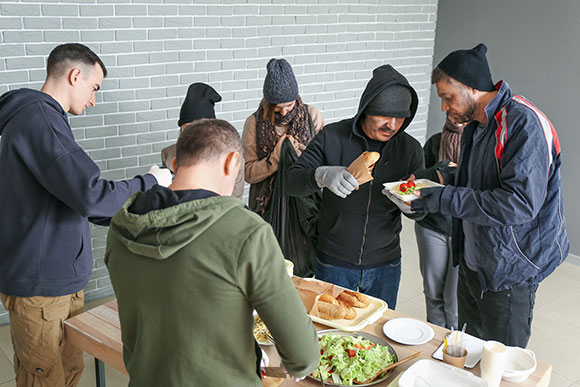
The former Cummings Elementary School building will serve as a warming center for unhoused residents through the winter months.
By Harry Kane
The city has decided to transform the former Cummings Elementary School building into an overnight warming center for unhoused residents during the cold months.
At the City Council meeting on November 26, the city appropriated $388,000 to cover the costs of the warming center that will be in operation from December 9 through April 15. An additional $35,000 for a restroom trailer and $30,000 for security has been allocated by the city.
The city is in the process of contracting a site operator and security vendor. The operator will provide a site supervisor, staff the warming center and contract internal security, explained Connor McCombs, health communications officer at the Department of Health & Human Services. “The city will contract with an external security presence and directed patrols by SPD. Site staffing and security may be adjusted as needed throughout the season.”
There will be an overnight capacity of 20-25 at the warming center, explained Public Information Officer Victoria MacGregor. “The capacity is based on operator-safe staffing levels. Capacity is also based on fire, building and shelter codes. A limited overflow is allowed in chairs, but not additional cots.”
The city determined the need for a warming center is greater than last year, and therefore hours of operation have increased to accommodate homeless residents who require shelter and are among Somerville’s most vulnerable.
Last winter, the warming center operated out of the second floor of the Armory. The operation lasted until March 24, but this year the city has extended the duration of the operation until April 13.
A warming center is a temporary night center for those experiencing homelessness, according to the City of Somerville website. The warming center will provide access to hot meals, bathrooms and safe sleeping spaces for residents experiencing homelessness.
“The warming center did not turn anyone away last year and will assess needs of unhoused from daily reporting from the operator,” said MacGregor. “If we had too many people, or families we could not accommodate, the operator can transport them to other shelters in the region.”
The warming center is a commitment from the city to provide a safe place to sleep during the coldest nights of the year, according to the City of Somerville’s website. The hours of operation are 7 days per week, 5 p.m. to 8 a.m.
“This is an extension of length of the duration of the program from last year,” said Karin Carroll, director of the Department of Health & Human Services during the City Council meeting on November 26.
The Cummings School building is located at 42 Prescott St. The former school building is named after John A. Cummings, the fifth Mayor of Somerville from 1881-1884, and the publisher of The Somerville Journal from 1872-1874.
The former school has been a mixed-use, city-owned building that was selected among five other buildings based on factors such as city ownership, heating, ADA compliance, no current shared use and proximity to the target population.
Access is through the Prescott St. side, using the gymnasium as an entry point to two separate rooms on the left. There are some planned upgrades to the indoor bathrooms, along with installation of fire alarms, painting and lighting additions.
This year’s costs have increased due to additional hours of operation, Carroll said. Roughly two-thirds of the money from the budget for the warming center goes towards paying personnel.
During a meeting on November 18, where members of the community discussed the future of the warming center, there was an attempt to obtain a heated trailer with showers, but unfortunately every one of the trailers containing showers is being used for hurricane relief. However, a restroom trailer will be available as a temporary solution due to the bathrooms at the Cummings School building being child-sized.
In addition to a new security firm, a transportation element has been added to assist individuals to travel to and from the warming center, Carroll added.
Based on last year’s data, the Davis Square neighborhood is where the majority of the homelessness come from, Carroll said. There will be a small van that will transport folks from Davis Square and other areas to the warming center. Taxi vouchers will also be provided if the van is not available to service the neighborhood.
“I’m very glad to hear that the transportation is in both directions,” said City Councilor President Ben Ewen-Campen. “I’m certainly in support of this.”
Ward 6 City Councilor Lance L. Davis questioned whether the van would only be used to transport individuals to and from Davis Square. “I’m glad to hear that we will be providing transportation that’s not just in police vehicles because I know that was a challenge for some folks last year,” said Councilor Davis. “I’m thrilled that folks will be transported from the Davis Square area where they can stay warm at night. What about folks elsewhere in the city?”
Carroll assured the councilors that transportation would be provided from other areas of Somerville as needed, and that taxi vouchers would substitute for the van, if the van was unavailable. “They will be able to go where the need is,” Carroll said, regarding the van’s daily route.
Jack Connolly, former Alderman from Ward 6, applauded the city’s effort to provide shelter for the homelessness with the addition of an overnight warming center.
“It’s going to shelter people from the cold … and obviously a winter’s night is not fun for anybody outside,” Connolly said. “It remains to be seen how effective it’s going to be and for how long it will last.”
Connolly explained that more homeless have filtered into Somerville since Boston Mayor Michelle Wu’s Administration removed tent encampments at the epicenter of the crisis at Massachusetts Avenue and Melnea Cass Boulevard.
Melnea Cass was known as the “First Lady of Roxbury,” and was an American community and civil rights activist.
“A lot of those folks maneuvered up the red lines to Central Square, to Davis [Square] and up to Alewife, and tend to congregate,” Connolly said.
Connolly says the “Davis Square Daytripper’s” come for the day, but tend to return at night. “For those people who don’t, yes, having a bus to Prescott Street to drop them off for shelter … I give the city credit for trying to put a Band-Aid on what’s probably an even bigger problem based on the number of people that are probably looking for somewhere to be.”















Reader Comments